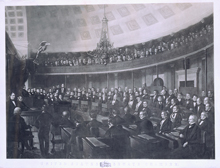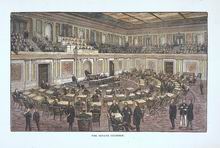"United States Senate Chamber."
Thomas Doney, after James Whitehorn
1846
"The Senate Chamber."
Unidentified Artist, after S.S. Kilburn
Picturesque Washington, ca. 1889
August 24, 1814 marks one of the darkest episodes in the War of 1812. On that day, British troops marched on Washington, DC, putting the American government to flight and burning many public buildings, including the U.S. Capitol. Among the losses in the Capitol were the Senate Chamber and all its contents. Reconstruction took until 1819, and when senators again took their seats in the rebuilt Chamber (now called the Old Senate Chamber), they occupied 48 new desks and chairs custom made by Thomas Constantine, a New York cabinetmaker. Constantine was paid $34 for each Senate desk, and $46 for each chair.
Today all of Constantine's desks remain in use in the current Senate Chamber, although his chairs have been replaced. As new states entered the Union, desks of similar design were ordered from other cabinetmakers; although, the four newest desks—those constructed for Alaska (1959) and Hawaii (1959)—were built in the Senate Cabinet Shop.
There are noticeable differences in shape and dimension among the 100 desks. These result from the original semicircular arrangement of the desks in the Old Senate Chamber. A desk's shape reflected its position in the room: aisle desks were narrow and angled, while center desks were wider and more square. If the oldest desks were arranged in the original layout, it is believed they would form a perfect semicircle.
Many traditions pertaining to the Senate desks have evolved over the years, and each new class of senators that occupies them contributes to their heritage. Through careful documentation and diligent preservation, this rich legacy will be maintained for future generations.

